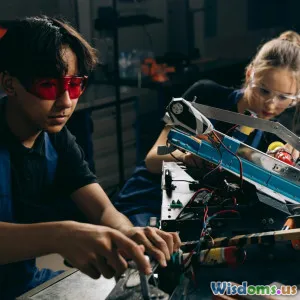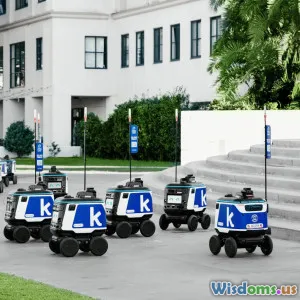
How Robots Are Reshaping Warehouse Jobs in 2024
8 min read Explore how robots are transforming warehouse jobs in 2024, blending AI and automation to enhance efficiency and workforce dynamics. (0 Reviews)
How Robots Are Reshaping Warehouse Jobs in 2024
Warehouse operations have long been a backbone of global commerce, powering the delivery of goods that fuel our consumer-driven economy. Yet, the way warehouses function is undergoing a monumental shift in 2024, with robots at the helm. From autonomous mobile robots (AMRs) to AI-powered sorting systems, robotics is not just enhancing how warehouses operate — it is fundamentally reshaping the nature of warehouse jobs. This in-depth exploration reveals how this evolution is underway, what it means for workers and businesses alike, and where the future is headed.
Introduction: The New Warehouse Revolution
Imagine walking into a sprawling warehouse where humans and robots work side-by-side seamlessly. Robots navigate aisles, transport bulky items with precision, and sort packages faster than ever, while workers focus on overseeing operations, troubleshooting exceptions, and handling complex tasks. This futuristic scene is already a reality in many logistic hubs and distribution centers worldwide, made possible by the rapid advancement of artificial intelligence (AI) and automation technologies.
The warehouse job market traditionally thrived on repetitive, physically intensive roles. Robots are now stepping in to take over such tasks, reducing injury risks and increasing throughput. However, this also provokes key questions: What happens to warehouse jobs? Are humans being replaced, or are their roles simply evolving? Let’s dive into the heart of this transformation happening in 2024.
The Rise of Robotics and AI in Warehousing
Autonomous Mobile Robots (AMRs) Transforming Material Handling
AMRs are intelligent machines equipped with sensors and AI software that allow them to navigate warehouse floors without predefined tracks. Unlike older conveyor or forklift-based systems, AMRs dynamically respond to changing environments.
Companies like Amazon Robotics deploy thousands of these AMRs in fulfillment centers. Each robot can carry up to 100kg of goods, efficiently moving inventory to packing stations. Thanks to AI algorithms, they optimize routes and avoid collisions, a feat that significantly accelerates warehouse workflows.
AI-Driven Sorting and Inventory Management
Beyond transportation, robotics equipped with AI vision systems conduct sorting tasks previously done manually. For example, Zebra Technologies introduces AI-powered scanners that identify product types and automatically sort packages onto the correct delivery paths.
Machine learning models also predict demand patterns, improving inventory stocking. Warehouses can now reduce overstock or stockouts, allowing businesses to respond rapidly to market trends.
Cobots Enhancing Human Roles
Collaborative robots, or cobots, are designed with human safety in mind to directly work alongside employees. Instead of replacing humans, these machines support workers by taking over strenuous repetitive actions like lifting heavy boxes, thus reducing workplace injuries by up to 40%, according to recent OSHA reports.
In turn, warehouse workers can focus on inspection, maintenance, and supervisory roles that require critical thinking and creativity—skills currently beyond robotic reach.
Real-World Insights: Case Studies and Data
DHL’s Smart Warehouse Initiative
DHL, a global logistics leader, revamped one of its warehouses in Germany in early 2024 by integrating robotic systems and AI analytics. According to DHL, robotic automation contributed to a 25% increase in order fulfillment speed and a 30% reduction in workplace accidents.
DHL’s Logistics Head Klaus Kohls stated, “With the integration of robotics, we’ve transformed our workforce into tech-savvy roles, empowering employees rather than displacing them.” This highlights a strategic approach focused on workforce development alongside technology adoption.
Walmart’s Hybrid Warehouse Workforce
Walmart has doubled down on robotics in its distribution centers, deploying robots that handle package scanning and sorting. Simultaneously, employees now receive training in robot maintenance and data analysis, illustrating how the human role is evolving. Workers earn higher wages reflecting these upskilled responsibilities.
Their data shows the blend of robots and humans lowers order processing errors by 15% and cuts physical strain injuries by half.
Challenges in the Robotic Warehouse Revolution
While benefits are robust, the transition also brings challenges:
- Workforce Reskilling: Rapid shifts demand substantial investment in employee training. Without proper programs, workers may feel displaced or overwhelmed.
- Initial Capital Costs: Robotics systems require large upfront costs, which may burden smaller warehouse operators.
- System Integration Complexity: Integrating heterogeneous robotic systems with existing warehouse management software can be technically challenging.
Industry experts argue that collaboration among governments, businesses, and educational institutions is essential to navigate these challenges and create sustainable workforce pathways.
The Future Landscape of Warehouse Jobs
From Manual Labor to Tech-Savvy Roles
As robots handle most manual tasks, warehouse jobs increasingly emphasize technology oversight, robotic maintenance, and data analytics. New roles such as Robotics Coordinators and AI Systems Supervisors are emerging.
Institutions like MIT and the Workforce Development Boards collaborate to offer certificates in these areas, helping workers transition smoothly.
Enhanced Safety and Worker Satisfaction
With robots managing hazardous tasks, employee injury rates are projected to decline further. Safer workplaces contribute to better morale, retention, and productivity.
Driving Sustainability
Robotics also drive greener operations: optimized routes reduce energy consumption, and AI analytics help minimize waste through precise inventory forecasting.
Conclusion: Embracing Robotics Without Losing the Human Touch
The reshaping of warehouse jobs in 2024 by robots is a testament to the power of AI and automation to transform industries. Far from substituting the human workforce, robotics is redefining roles, cultivating new skill sets, and enabling safer, more efficient workplaces.
For businesses, the path forward involves smart investment in technology alongside a deep commitment to reskilling workers. For employees, embracing lifelong learning and adaptability will open doors to rewarding tech-integrated careers.
The robot workforce revolution is here—and it is reshaping warehouses not just with smarter machines, but with empowered humans driving the future together.
Illustrative references available through industry reports from DHL, OSHA safety data, and Walmart’s automation updates in 2024.
Rate the Post
User Reviews
Popular Posts





















